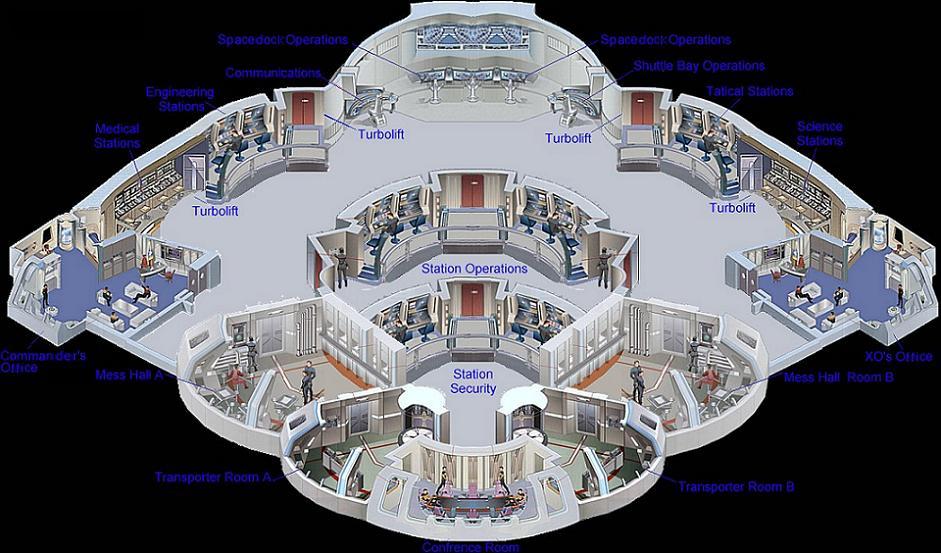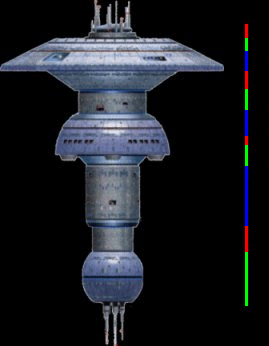Spacedock: Difference between revisions
m (updated) |
m (added construction history) |
||
| Line 41: | Line 41: | ||
A spacedock was a facility capable of docking starships for maintenance. Most spacefaring species had some type of spacedock, and they thus varied widely in design. Within the United Federation of Planets, and its immediate predecessors, a spacedock most often took the form of a free-standing, orbital, single-starship-sized "cage". This form of spacedock was virtually synonymous with the word drydock. Examples included McKinley Station and the unnamed facilities which launched the refit Enterprise (NCC-1701) and the NX-01, as well as the many individual spacedocks that comprised the Utopia Planitia Fleet Yards. Generally, these cage designs were for major construction or refits. | A spacedock was a facility capable of docking starships for maintenance. Most spacefaring species had some type of spacedock, and they thus varied widely in design. Within the United Federation of Planets, and its immediate predecessors, a spacedock most often took the form of a free-standing, orbital, single-starship-sized "cage". This form of spacedock was virtually synonymous with the word drydock. Examples included McKinley Station and the unnamed facilities which launched the refit Enterprise (NCC-1701) and the NX-01, as well as the many individual spacedocks that comprised the Utopia Planitia Fleet Yards. Generally, these cage designs were for major construction or refits. | ||
===CONSTRUCTION HISTORY=== | |||
Officially known as the “Star Fleet Repair and Service Facilityâ€, since the first two tritanium girders were gamma-welded together, it has been known simply as “Spacedockâ€. When it became operational in 2274, it was one of the largest artificial satellites ever placed in orbit. | |||
'''Class:''' Spacedock was conceived in the 2250’s to serve as both a more elaborate docking facility then the free-standing single-ship dockworks and also as an orbital command center for not only the San Francisco Yards, but all starship construction facilities along the Pacific Hemisphere. In addition, Star Fleet Command moved command of the 7th Fleet to Spacedock and the extremely powerful communications relays were located at the top of the facility. | |||
While most starship construction continues to take place in the free-standing facilities, final outfitting and testing / shakedown / PSA trials are completed from Spacedock. The extensive support facilities that this structure supplies make such jobs far more efficient. | |||
'''Classification:''' Spacedock is classified as a starbase, as she combines the administrative and orbital dockyard facilities of one. She was the first starbase not to use the word in her title, but now “starbase†is reserved for Star Fleet-specific facilities. | |||
'''Design:''' Built to provide orbital construction and docking facilities far more elaborate than the skeletal-structures formerly used, it also offers administrative offices, apartments, cargo handling and storage, specialized lab and manufacturing facilities, and just about anything else. | |||
The upper hangar spans almost four kilometers in diameter and can hold every ship class in current and projected Federation service. The upper dockyards are the exclusive realm of Starfleet, with commercial traffic using the facilities in the lower docking bell, accessed through four doors on the underside. Much of this lower space is set aside for cargo transit and storage and includes customs and freight-handling facilities. The topmost level of the facility is given over to powerful communication towers capable of handling the entire communications volume of the sector. The Command Center and senior administrative offices are also located here. | |||
Spacedock has a normal resident operational staff approaching 50,000. The station is also home to some 100,000 resident dependents from Terra and other systems. The daily transient population can reach upwards of 20,000. | |||
'''Engineering:''' At the time of her construction, the FMAPG-X1 Matter/Anti-Matter Reaction Control Assembly was the most powerful in existence. Capable of powering a small city, it provides the power necessary to run the station and all her systems. Orbital positioning is provided by a massive FIPG-X1 impulse drive system. | |||
'''Tactical:''' Due to its location, Spacedock is extremely well-armed. Tactical weapons include fifty high output (Type X+) phaser arrays assigned ten to a quadrant along with twenty Mk 90 photon torpedo launchers (five per quadrant). The FDSG-X1 shield system can withstand attacks by elements up to the Task Force level. | |||
'''Builders:''' The facility was built by specialized teams from the Star Fleet Corps of Engineers with experience in large-scale orbital structures. Prime Contractor was Genom Construction, who specialized in massive constructs. | |||
Development and Construction History: Construction began in 2263 and the outer frame was completed in 2268 with interior outfitting continuing until 2274 when the facility went online. Updates to her computer and tactical systems have been ongoing and the main doors were widened in 2315 to allow Ambassador class, and again in 2355 for Galaxy class, starships to use the facility. | |||
===OPS LAYOUT=== | ===OPS LAYOUT=== | ||
Revision as of 22:57, 22 December 2008
Spacedock Class
UNITED FEDERATION OF PLANETS: STARFLEET DIVISION
Advanced Technical Specifications for the Spacedock-Class Production
| Accommodation: | 282505 (5205 officers, 75000 enlisted, 2300 marines, and 200000 civilians) | |
| Funding Provided by: | ||
| Advanced Starship Design Bureau | Current Starbase Identification and Registration Numbers: | |
| United Federation of Planets Defense Council | Kemaris Station | |
| Production Start Date: | 2371 | |
| Production End Date: | Still in Production | |
| Current Status: | In Service |
SPACEDOCK-CLASS INTRODUCTION
MISSION OBJECTIVES
A spacedock was a facility capable of docking starships for maintenance. Most spacefaring species had some type of spacedock, and they thus varied widely in design. Within the United Federation of Planets, and its immediate predecessors, a spacedock most often took the form of a free-standing, orbital, single-starship-sized "cage". This form of spacedock was virtually synonymous with the word drydock. Examples included McKinley Station and the unnamed facilities which launched the refit Enterprise (NCC-1701) and the NX-01, as well as the many individual spacedocks that comprised the Utopia Planitia Fleet Yards. Generally, these cage designs were for major construction or refits.
CONSTRUCTION HISTORY
Officially known as the “Star Fleet Repair and Service Facilityâ€, since the first two tritanium girders were gamma-welded together, it has been known simply as “Spacedockâ€. When it became operational in 2274, it was one of the largest artificial satellites ever placed in orbit.
Class: Spacedock was conceived in the 2250’s to serve as both a more elaborate docking facility then the free-standing single-ship dockworks and also as an orbital command center for not only the San Francisco Yards, but all starship construction facilities along the Pacific Hemisphere. In addition, Star Fleet Command moved command of the 7th Fleet to Spacedock and the extremely powerful communications relays were located at the top of the facility.
While most starship construction continues to take place in the free-standing facilities, final outfitting and testing / shakedown / PSA trials are completed from Spacedock. The extensive support facilities that this structure supplies make such jobs far more efficient.
Classification: Spacedock is classified as a starbase, as she combines the administrative and orbital dockyard facilities of one. She was the first starbase not to use the word in her title, but now “starbase†is reserved for Star Fleet-specific facilities.
Design: Built to provide orbital construction and docking facilities far more elaborate than the skeletal-structures formerly used, it also offers administrative offices, apartments, cargo handling and storage, specialized lab and manufacturing facilities, and just about anything else.
The upper hangar spans almost four kilometers in diameter and can hold every ship class in current and projected Federation service. The upper dockyards are the exclusive realm of Starfleet, with commercial traffic using the facilities in the lower docking bell, accessed through four doors on the underside. Much of this lower space is set aside for cargo transit and storage and includes customs and freight-handling facilities. The topmost level of the facility is given over to powerful communication towers capable of handling the entire communications volume of the sector. The Command Center and senior administrative offices are also located here.
Spacedock has a normal resident operational staff approaching 50,000. The station is also home to some 100,000 resident dependents from Terra and other systems. The daily transient population can reach upwards of 20,000.
Engineering: At the time of her construction, the FMAPG-X1 Matter/Anti-Matter Reaction Control Assembly was the most powerful in existence. Capable of powering a small city, it provides the power necessary to run the station and all her systems. Orbital positioning is provided by a massive FIPG-X1 impulse drive system.
Tactical: Due to its location, Spacedock is extremely well-armed. Tactical weapons include fifty high output (Type X+) phaser arrays assigned ten to a quadrant along with twenty Mk 90 photon torpedo launchers (five per quadrant). The FDSG-X1 shield system can withstand attacks by elements up to the Task Force level.
Builders: The facility was built by specialized teams from the Star Fleet Corps of Engineers with experience in large-scale orbital structures. Prime Contractor was Genom Construction, who specialized in massive constructs. Development and Construction History: Construction began in 2263 and the outer frame was completed in 2268 with interior outfitting continuing until 2274 when the facility went online. Updates to her computer and tactical systems have been ongoing and the main doors were widened in 2315 to allow Ambassador class, and again in 2355 for Galaxy class, starships to use the facility.
OPS LAYOUT
Deck Layout
Red 1 (Decks 1 - 118) Operations Centre (Ops), CO's Ready Room, XO's Office, Command Chief's Office, Conference Facilities, Executive Lounges, Senior Crew Quarters, VIP Quarters
Green 1 (Decks 119 - 229) Department Head Offices, Diplomatic Detachment Offices, Intelligence Department Offices, Medical Facilities, Science Laboratories, Facilities & Offices, Security Training Facilities, Strategic Operations Offices
Blue 1 (Decks 230 - 400) Starship Docking facilities, Dock Master's Offices, Starship Development Departmental Offices
Red 2 (Decks 400 - 553) Commercial Areas, Security Public Relations Office 1
Green 2 (Decks 554 - 735) Cargo Storage Facilities
Blue 2 (Decks 736 - 957) Commericial Areas, Security Public Relations Office 2
Red 3 (Decks 958 - 1033) Small Craft Docking Facilities, Fighter Operations offices, Spacecraft Ops offices
Green 3 (Decks 1034 - 1214) Fighter Operations Conference & Planning Facilities, Spacecraft Ops Conference & Planning Facilities, Crew Quarters
Blue 3 (Decks 1215 - 1725) Civilian Residential Apartments
Red 4 (Decks 1726 - 1945) Recreational Facilities
Green 4 (Decks 1946 - 2400) Computer Cores, Fusion Reactor Systems, Operations Departmental offices


